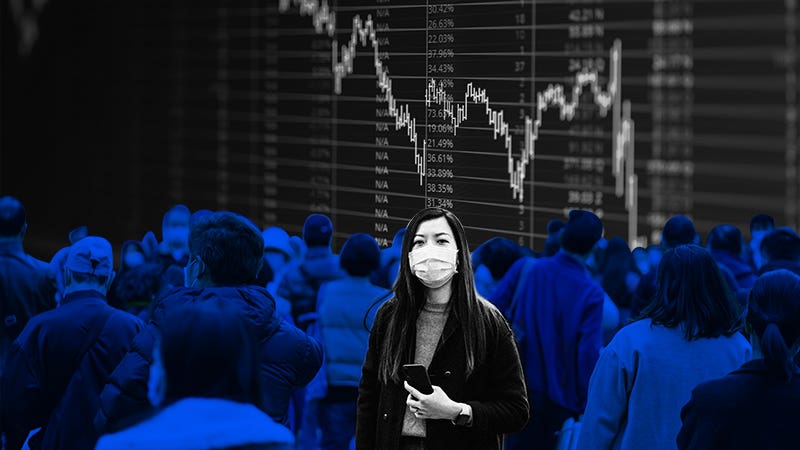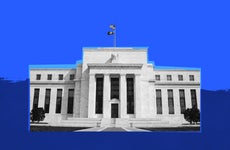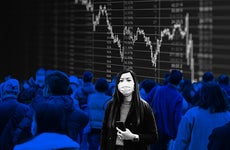Survey: Top economists see slowing economic recovery from coronavirus pandemic in 2021

The Bankrate promise
At Bankrate we strive to help you make smarter financial decisions. While we adhere to strict , this post may contain references to products from our partners. Here's an explanation for .
The U.S. economy in 2021 will continue to recover from this year’s steep coronavirus-induced downturn, but at a much slower pace than earlier in the spring, according to Bankrate’s Fourth-Quarter Economic Indicator survey.
The nation’s top economists are expecting joblessness a year from now to sink by less than one percentage point — to about 6 percent, compared with its current level of 6.7 percent — meaning unemployment will still hold well above pre-pandemic levels. Meanwhile, U.S. employers are seen as adding back an average of 321,205 positions a month, a tepid pace that sets the stage for another 2.5 more years before the financial system fully recovers the 22.2 million positions lost during the pandemic.
But highlighting increased optimism about the economy, a growing number of economists compared with previous survey periods say the U.S. financial system has more good going for it than bad. That comes as health care officials embark on the early stages of distributing the coronavirus vaccine and lawmakers finally passed a second major stimulus package to help blunt the blow of rising caseloads and elevated unemployment.
“Since the pandemic is still raging, there’s a high degree of uncertainty about the future direction of the economy,” says Mark Hamrick, Bankrate’s senior economic analyst. “But we have reason for hope. Some improvement is expected over the coming year, but the recovery will be uneven with respect to specific areas of the country and sectors of the economy.”
Below are the findings from Bankrate’s survey, which polled 24 economists on where they see unemployment, job creation and interest rates going over the next 12 months.
Key takeaways:
- Economists see 6 percent unemployment a year from now.
- Experts see the U.S. economy adding an average of 321,205 new positions each month over the next 12 months.
- Majority (50 percent) of economists say risks are tilted toward the upside over the next 12-18 months.
- Interest rates will stay at rock-bottom levels, though the 10-year Treasury yield is expected to rise slightly.
- More than 2 in 5 economists say Georgia’s Senate run-off election this January will impact the economy “a great deal.”
Economists see unemployment at 6 percent a year from now
The U.S. labor market has mounted a dramatic reversal from its earlier upheaval, with employers so far bringing back roughly half (or 55 percent) of the 22.2 million positions lost to nationwide stay-at-home orders intended to stop the virus from spreading. At the same time, the unemployment rate has crept down to 6.7 percent after soaring as high as 14.7 percent in April.
But while economists in Bankrate’s survey expect the improvement to continue, economic hardship is bound to persist.
While economists’ unemployment rate forecasts averaged out to 6 percent, responses were still wide-ranging, though to a lesser degree than previous polls. The highest forecast penciled in a 7.4 percent unemployment rate, meaning joblessness would increase by this time next year. The lowest estimate was 5 percent, meaning a 1.7 percentage point improvement from its current level.
“This [new round of] stimulus will serve as a necessary bridge to later in 2021 when, as the U.S. population gains access to vaccines that prevent COVID-19, we expect economic growth to pick up, and employers to gain confidence and increase hiring,” says Danielle Hale, chief economist at Realtor.com.
Surprisingly, Bankrate’s economists were significantly more pessimistic than Federal Reserve officials, whose latest economic projections show joblessness bottoming out at 5 percent by the end of 2021.
But they’re still more upbeat than previous iterations of Bankrate’s Economic Indicator poll. Experts back in September predicted that unemployment would fall to 7 percent by the third quarter of 2021, a threshold the labor market has already crossed. Meanwhile, in June, experts saw joblessness falling to 10 percent by the second quarter of 2021. All of that shows that the U.S. economy’s rebound has been more robust than most experts had expected it would be when the crisis took hold.
But despite the range of views and the differing forecasts, both Fed projections and Bankrate’s survey demonstrate a strong likelihood that the U.S. labor market won’t be returning to its pre-pandemic environment anytime soon. Before the crisis took hold, unemployment was at its lowest in half a century, bottoming out at 3.5 percent.
Experts see U.S. employers adding an average of 321,205 jobs each month
Part of the reasoning behind expecting elevated unemployment is a general prediction that employers won’t see enough demand to boost hiring. That has grave implications for the nearly 10 million more Americans who are jobless at the end of 2020 compared with before the pandemic.
Economists in Bankrate’s survey are penciling in slightly lower job gains than in previous surveys. Experts in Bankrate’s fourth-quarter poll expect employers to add an average of 321,205 positions over the next 12 months. That’s down slightly from economists’ third-quarter forecasts for a 369,000 average monthly job gain and significantly lower than the 887,000 average gain expected each month back in the second quarter of 2020.
Still, experts’ latest forecasts are better than the latest monthly jobs report, which showed that employers added a meager 245,000 positions in November, the slowest pace thus far. But it keeps up with the trend of slowing job gains, down significantly from the 4.9 million snapback in June, the quickest pace of the recovery.
Even the more optimistic survey participants aren’t expecting job gains to arrive at that fast of a pace over the next 12 months, with the highest forecast being an average monthly gain of 663,000.
The lowest forecast expects a modest 133,000 average monthly job gain. At that pace, it would take more than six years before the economy fully closes its coronavirus jobs deficit.
“The first phase of the labor market was very strong, but with 9.8 million fewer jobs relative to pre-pandemic levels, the permanent unemployment share at 44 percent and the share of those unemployed for more than six months at 37 percent, the road to a full recovery will be long,” says Gregory Daco, chief economist at Oxford Economics.
Half of economists say balance of risks are tilted toward the upside over the next 12-18 months
But even with somewhat bleak labor market forecasts, just 33 percent of economists say the balance of risks for the U.S. economy are tilted toward the downside over the next 12-18 months — the smallest share since the coronavirus crisis first took hold. About 88 percent of economists in Bankrate’s first-quarter poll said that risks were tilted toward the downside, compared with 38 percent in the second-quarter and 44 percent in the third quarter.
Half of experts (50 percent) say risks are tilted toward the upside, while 12 percent say risks are evenly balanced and another 4 percent didn’t know. All of that highlights the U.S. economy’s continued trajectory out of the deep recession, with the potential for an effective vaccine being the main driver of economic growth next year.
“The arrival of a vaccine will permit the resumption of normal social and economic activity stimulating a boom in the second half of 2021,” says Joe Brusuelas, chief economist at RSM.
Interest rates will stay at rock-bottom levels, though 10-year Treasury yield expected to rise slightly
Among experts polled for Bankrate’s survey, the U.S. central bank was also at the heart of increased optimism for the financial system next year. Officials have echoed that they’re not even “thinking about thinking about raising interest rates.” Translation: Fed Chairman Jerome Powell and Co. want the economy to run hot.
As such, 96 percent of participants in Bankrate’s fourth-quarter poll see the Fed leaving interest rates alone over the coming year, while one participant selected “don’t know.”
“The Fed won’t even discuss raising short-term rates in 2021,” says Bernard Baumohl, chief global economist at the Economic Outlook Group. “In a sharp departure from the past, they will remove the metaphorical punch bowl this time only when the party is well underway and even rowdy. That means rates will remain zero-bound for the next three to five years.”
Adding even more color, a separate Bankrate survey sees the Fed holding interest rates at rock-bottom levels until 2024, even as the financial system faces the potential of being “supercharged” when a vaccine is in the mix.
But the yields that serve as a benchmark for longer periods of borrowing, such as mortgages, could tick up, though only slightly. The average forecast among economists for the 10-year Treasury rate — which serves as a benchmark for the 30-year mortgage — 12 months from now is 1.25 percent, according to the poll. That implies a 33 basis point increase from where the 10-year closed at the end of Bankrate’s survey period on Dec. 10 and would be the highest since February, when the coronavirus crisis had just started to take hold.
The Fed, however, could take steps to keep those rates at historically low levels by buying longer-dated maturities.
“The Fed is going to do all in its power to get to a high-pressure economy that delivers wage gains,” says Diane Swonk, chief economist at Grant Thornton. “That means keeping rates close to zero for an indefinite period of time.”
More than 2 in 5 experts say Senate run-off elections mean a “great deal” for economy
But key to the continued rebound will also be fiscal policy. The latest coronavirus stimulus bill ends months of persistent gridlock, just days before relief programs crucial to Americans’ financial survivability during the pandemic were set to expire.
“Everyone is focused on people coming back to work and on government payout plans. All well and good,” says Robert Brusca, chief economist at Fact and Opinion Economics. “But a lot of people and a lot of businesses have fallen through the cracks of uneven support programs. They are struggling. When the mortgage payment hiatus is over there could be some real severe dislocations. Do not underestimate the undertow current.”
President-elect Joe Biden will soon be the one having to bring lawmakers to any future stimulus deals, with his transition to the White House looming. Part of that picture includes an early January run-off election for two Senate seats in Georgia, which could ultimately control the balance of power in Congress. Nearly 9 in 10 economists say the Georgia run-off elections matter either “a great deal” or “somewhat” for the economy’s trajectory. One participant said “other,” while two marked “don’t know or no answer.”
Experts suggest that Democrats controlling both chambers of Congress could mean more agreement and an easier path to more stimulus, while a split Congress might mean more roadblocks for the Biden administration.
“The Senate will determine if Biden gets much done,” says Joel L. Naroff, president at Naroff Economics. “If it remains Republican, gridlock will reign. If the Democrats win both races in Georgia, they will act rapidly and strongly passing their agenda.”
What this means for you
Given that the economic hardship is bound to persist even as the U.S. economy mounts its continued rebound next year, prioritize saving and cutting back on spending as much as possible to juice up your emergency fund. If you’re facing joblessness, work out a forbearance program or payment plan with any financial firms that you regularly pay a bill to. If you’re carrying credit card debt, consider making headway on those debt repayments while interest rates are at historic lows.
“This painful economic downturn has provided another reminder why more Americans should try to save for emergencies as best they can,” Hamrick says. “Whether it’s something that’s occurred in our personal lives, or a dramatic event affecting so many as the pandemic, those who had emergency savings to tap were better positioned for the storm.”
Methodology
The Fourth-Quarter 2020 Bankrate Economic Indicator Survey of economists was conducted Dec. 2-10. Survey requests were emailed to economists nationwide, and responses were submitted voluntarily online. Responding were: Scott Anderson, executive vice president and chief economist, Bank of the West; Scott J. Brown, chief economist, Raymond James Financial; Ryan Sweet, director of real-time economics, Moody’s Analytics; Bernard Markstein, president and chief economist, Markstein Advisors; John E. Silvia, president, Dynamic Economic Strategy; Mike Fratantoni, chief economist, Mortgage Bankers Association; Diane Swonk, chief economist, Grant Thornton LLP; Lindsey Piegza, Ph.D., chief economist, Stifel; Lynn Reaser, chief economist, Point Loma Nazarene University; Joel L. Naroff, president, Naroff Economic Advisors; Robert A. Brusca, chief economist, FAO Economics; Tenpao Lee, Ph.D., professor of economics, Niagara University; Robert Hughes, senior research fellow, American Institute for Economic Research (AIER); Danielle Hale, chief economist, realtor.com; Lawrence Yun, chief economist, National Association of REALTORS(R); Robert Dietz, senior vice president and chief economist, National Association of Home Builders; Odeta Kushi, deputy chief economist, First American Financial Corporation; Robert Frick, corporate economist, Navy Federal Credit Union; Mike Englund, chief economist, Action Economics; Bill Dunkelberg, chief economist, NFIB; Daniil Manaenkov, chief U.S. economist, RSQE at the University of Michigan; Bernard Baumohl, chief global economist, the Economic Outlook Group LLC; Gregory Daco, chief U.S. economist, Oxford Economics; and Joe Brusuelas, chief economist, RSM U.S.
Related Articles

Survey: Top economists say U.S. economy won’t be fully recovered from pandemic 12 months from now

Survey: America’s top economists expect double-digit unemployment rate into 2021

Forecast survey: Economy’s slow rebound from coronavirus free fall will keep Fed on hold until 2022

Survey: Coronavirus outbreak has the potential to threaten US economic growth